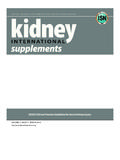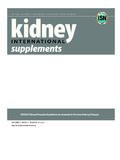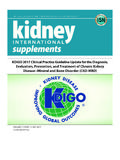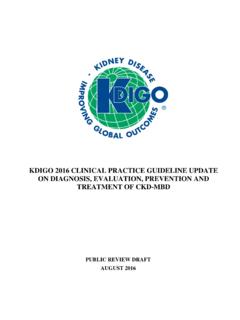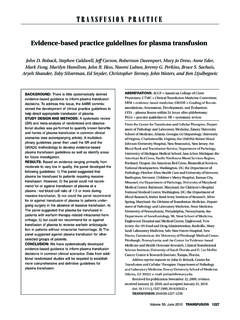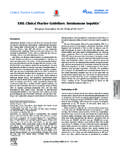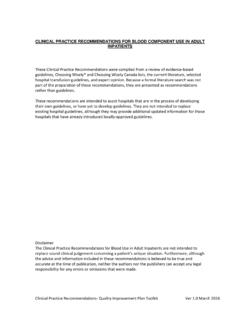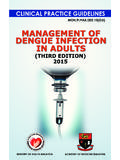Transcription of KDIGO Clinical Practice Guideline for …
1 Official Journal of the International Society of Nephrology KDIGO Clinical Practice Guideline for glomerulonephritis volume 2 | issue 2 | JUNE 2012. KDIGO Clinical Practice Guideline for glomerulonephritis KDIGO gratefully acknowledges the following consortium of sponsors that make our initiatives possible: Abbott, Amgen, Belo Foundation, Coca-Cola Company, Dole Food Company, Genzyme, Hoffmann-LaRoche, JC Penney, NATCO The Organization for Transplant Professionals, NKF-Board of Directors, Novartis, Robert and Jane Cizik Foundation, Roche, Shire, Transwestern Commercial Services, and Wyeth. Sponsorship Statement: KDIGO is supported by a consortium of sponsors and no funding is accepted for the development of specific guidelines . contents & 2012 KDIGO . VOL 2 | SUPPLEMENT 2 | JUNE 2012. KDIGO Clinical Practice Guideline for glomerulonephritis v Tables vi KDIGO Board Members vii Reference Keys viiii Abbreviations and Acronyms 139 Notice 140 Foreword 141 Work Group Membership 142 Abstract 143 Summary of Recommendation Statements 154 Chapter 1: Introduction 156 Chapter 2: General principles in the management of glomerular disease 163 Chapter 3: Steroid-sensitive nephrotic syndrome in children 172 Chapter 4: Steroid-resistant nephrotic syndrome in children 177 Chapter 5: Minimal-change disease in adults 181 Chapter 6: Idiopathic focal segmental glomerulosclerosis in adults 186 Chapter 7: Idiopathic membranous nephropathy 198 Chapter 8: Idiopathic membranoproliferative glomerulonephritis 200 Chapter 9: Infection-related glomerulonephritis 209 Chapter 10: Immunoglobulin A nephropathy 218 Chapter 11: Henoch-Scho nlein purpura nephritis 221 Chapter 12.
2 Lupus nephritis 233 Chapter 13: Pauci-immune focal and segmental necrotizing glomerulonephritis 240 Chapter 14: Anti-glomerular basement membrane antibody glomerulonephritis 243 Methods for Guideline development 252 Biographic and Disclosure Information 258 Acknowledgments 259 References contents & 2012 KDIGO . TABLES. 164 Table 1. Definitions of nephrotic syndrome in children 167 Table 2. Meta-analyses of RCTs of corticosteroid-sparing agents in children with FR or SD SSNS. 168 Table 3. RCTs comparing corticosteroid-sparing agents in FR and SD SSNS. 169 Table 4. Advantages and disadvantages of corticosteroid-sparing agents as first agent for use in FR or SD SSNS. 174 Table 5. CNI trials in SRNS. 175 Table 6. Remission in corticosteroid-treated control arms of SRNS randomized trials 175 Table 7. Cytotoxic therapy in SRNS. 178 Table 8. Dosage regimens in MCD. 182 Table 9. Causes of FSGS. 183 Table 10.
3 Definitions of nephrotic syndrome in adults with FSGS. 184 Table 11. Treatment schedules 187 Table 12. Reported causes of secondary MN (% in adults). 188 Table 13. Reported causes of secondary MN. 188 Table 14. Definitions of complete and partial remission in IMN. 189 Table 15. Cyclical corticosteroid/alkylating-agent therapy for IMN (the "Ponticelli Regimen"). 190 Table 16. Risks and benefits of the cyclical corticosteroid/alkylating-agent regimen in IMN. 191 Table 17. Contraindications to the use of the cyclical corticosteroid/alkylating-agent regimen in IMN. 192 Table 18. CNI-based regimens for IMN. 197 Table 19. Pediatric MN studies 199 Table 20. Underlying conditions associated with a membranoproliferative pattern of GN. 201 Table 21. Infections associated with glomerulonephritis 203 Table 22. Treatment of HCV infection according to stages of CKD. 204 Table 23. Dosage adjustment of drugs for HBV infection according to kidney function (endogenous CrCl).
4 205 Table 24. The spectrum of kidney disease in HIV-infected patients 206 Table 25. A clinicopathological classification of schistosomal glomerulopathy 211 Table 26. Corticosteroid regimens in patients with IgAN. 222 Table 27. Definitions of response to therapy in LN. 223 Table 28. Regimens for initial therapy in class III/class IV LN. 229 Table 29. Criteria for the diagnosis and classification of relapses of LN. 234 Table 30. Recommended treatment regimens for ANCA vasculitis with GN. 241 Table 31. Therapy of anti-GBM GN. 244 Table 32. Screening criteria for systematic review topics of nontreatment and treatment 248 Table 33. Literature search yield of RCTs 248 Table 34. Hierarchy of outcomes 249 Table 35. Classification of study quality 250 Table 36. GRADE system for grading quality of evidence 250 Table 37. Final grade for overall quality of evidence 250 Table 38. Balance of benefits and harm 251 Table 39.
5 KDIGO nomenclature and description for grading recommendations 251 Table 40. Determinants of strength of recommendation Additional information in the form of supplementary materials can be found online at Kidney International Supplements (2012) 2, v v & 2012 KDIGO . KDIGO Board Members Garabed Eknoyan, MD. Norbert Lameire, MD, PhD. Founding KDIGO Co-Chairs Kai-Uwe Eckardt, MD Bertram L Kasiske, MD. KDIGO Co-Chair KDIGO Co-Chair Omar I Abboud, MD, FRCP Michel Jadoul, MD. Sharon Adler, MD, FASN Simon Jenkins, MBE, FRCGP. Rajiv Agarwal, MD Suhnggwon Kim, MD, PhD. Sharon P Andreoli, MD Martin K Kuhlmann, MD. Gavin J Becker, MD, FRACP Nathan W Levin, MD, FACP. Fred Brown, MBA, FACHE Philip K-T Li, MD, FRCP, FACP. Daniel C Cattran, MD, FRCPC Zhi-Hong Liu, MD. Allan J Collins, MD, FACP Pablo Massari, MD. Rosanna Coppo, MD Peter A McCullough, MD, MPH, FACC, FACP. Josef Coresh, MD, PhD Rafique Moosa, MD.
6 Ricardo Correa-Rotter, MD Miguel C Riella, MD. Adrian Covic, MD, PhD Adibul Hasan Rizvi, MBBS, FRCP. Jonathan C Craig, MBChB, MM (Clin Epi), DCH, FRACP, PhD Bernardo Rodriquez-Iturbe, MD. Angel de Francisco, MD Robert Schrier, MD. Paul de Jong, MD, PhD Justin Silver, MD, PhD. Ana Figueiredo, RN, MSc, PhD Marcello Tonelli, MD, SM, FRCPC. Mohammed Benghanem Gharbi, MD Yusuke Tsukamoto, MD. Gordon Guyatt, MD, MSc, BSc, FRCPC Theodor Vogels, MSW. David Harris, MD Angela Yee-Moon Wang, MD, PhD, FRCP. Lai Seong Hooi, MD Christoph Wanner, MD. Enyu Imai, MD, PhD David C Wheeler, MD, FRCP. Lesley A Inker, MD, MS, FRCP Elena Zakharova, MD, PhD. NKF- KDIGO Guideline DEVELOPMENT STAFF. Kerry Willis, PhD, Senior Vice-President for Scientific Activities Michael Cheung, MA, Guideline Development Director Sean Slifer, BA, Guideline Development Manager Kidney International Supplements (2012) 2, vi vi & 2012 KDIGO .
7 Reference Keys NOMENCLATURE AND DESCRIPTION FOR RATING Guideline . RECOMMENDATIONS. Within each recommendation, the strength of recommendation is indicated as Level 1, Level 2, or Not Graded, and the quality of the supporting evidence is shown as A, B, C, or D. Implications Grade*. Patients Clinicians Policy Level 1 Most people in your situation Most patients should receive the The recommendation can be We recommend'' would want the recommended recommended course of action. evaluated as a candidate for course of action and only a small developing a policy or a proportion would not. performance measure. Level 2 The majority of people in your Different choices will be appropriate for The recommendation is likely to We suggest'' situation would want the different patients. Each patient needs help to require substantial debate and recommended course of action, arrive at a management decision consistent involvement of stakeholders before but many would not.
8 With her or his values and preferences. policy can be determined. *The additional category Not Graded'' was used, typically, to provide guidance based on common sense or where the topic does not allow adequate application of evidence. The most common examples include recommendations regarding monitoring intervals, counseling, and referral to other Clinical specialists. The ungraded recommendations are generally written as simple declarative statements, but are not meant to be interpreted as being stronger recommendations than Level 1 or 2 recommendations. Grade Quality of evidence Meaning A High We are confident that the true effect lies close to that of the estimate of the effect. B Moderate The true effect is likely to be close to the estimate of the effect, but there is a possibility that it is substantially different. C Low The true effect may be substantially different from the estimate of the effect.
9 D Very Low The estimate of effect is very uncertain, and often will be far from the truth. CONVERSION FACTORS OF METRIC UNITS TO SI UNITS. Parameter Metric units Conversion factor SI units Albumin (serum) g/dl 10 g/l Creatinine (serum) mg/dl mmol/l Creatinine clearance ml/min ml/s Cyclosporine (serum) ng/ml nmol/l uPCR mg/g mg/mmol Note: Metric unit conversion factor SI unit. Kidney International Supplements (2012) 2, vii vii & 2012 KDIGO . Abbreviations and Acronyms ACE-I Angiotensin-converting enzyme inhibitor(s) IMN Idiopathic membranous nephropathy ACTH Adrenocorticotropic hormone INR International normalized ratio AKI Acute kidney injury ISKDC International Study of Kidney Disease in ALMS Aspreva Lupus Management Study Children ANCA Antineutrophil cytoplasmic antibody IU International units APOL1 Apolipoprotein L1 KDIGO Kidney Disease: Improving Global Outcomes APS Antiphospholipid antibody syndrome LN Lupus nephritis ARB Angiotensin-receptor blocker MCD Minimal-change disease ATN Acute tubular necrosis MDRD Modification of Diet in Renal Disease BMI Body mass index MEPEX Methylprednisolone or Plasma Exchange CI Confidence interval MMF Mycophenolate mofetil CKD Chronic kidney disease MN Membranous nephropathy CNI Calcineurin inhibitor MPGN Membranoproliferative glomerulonephritis CrCl Creatinine clearance MPO Myeloperoxidase eGFR Estimated glomerular filtration rate NCGN Necrotizing and crescentic ERT Evidence Review Team glomerulonephritis ESRD End-stage renal disease NS Not significant FR Frequently relapsing OR Odds ratio FRNS Frequently relapsing nephrotic syndrome PCR Protein-creatinine ratio FSGS Focal segmental glomerulosclerosis Oral(ly).
10 GBM Glomerular basement membrane PR3 Proteinase 3. GFR Glomerular filtration rate RAS Renin-angiotensin system GN glomerulonephritis RAVE Rituximab for the Treatment of Wegener's GRADE Grading of Recommendations Assessment, Granulomatosis and Microscopic Polyangiitis Development and Evaluation RCT Randomized controlled trial HAART Highly active antiretroviral therapy RR Relative risk HBV Hepatitis B virus RRT Renal replacement therapy HCV Hepatitis C virus SCr Serum creatinine HIVAN Human immunodeficiency SD Steroid-dependent virus associated nephropathy SLE Systemic lupus erythematosus HR Hazards ratio SRNS Steroid-resistant nephrotic syndrome HSP Henoch-Scho nlein purpura SSNS Steroid-sensitive nephrotic syndrome HSV Herpes simplex virus TMA Thrombotic microangiopathies Intravenous TTP Thrombotic thrombocytopenic purpura IgAN Immunoglobulin A nephropathy uPCR Urine protein:creatinine ratio Kidney International Supplements (2012) 2, viii viii & 2012 KDIGO .
